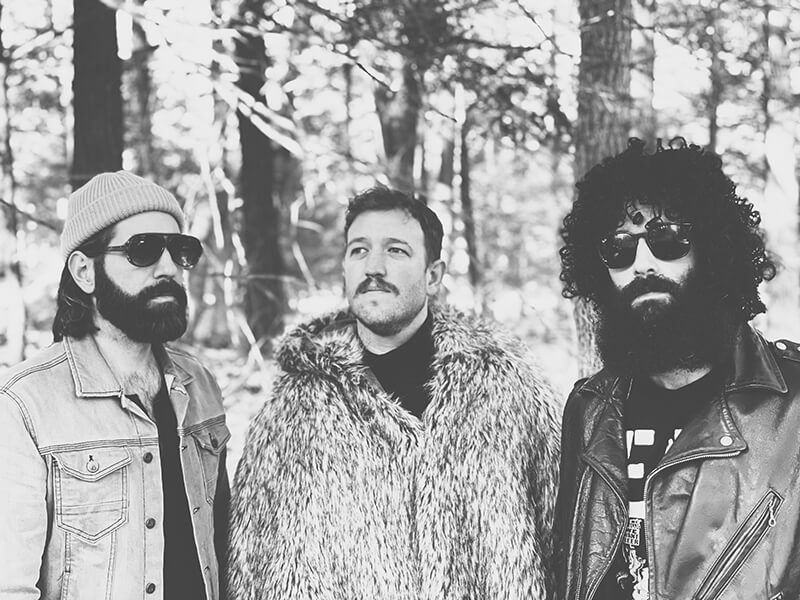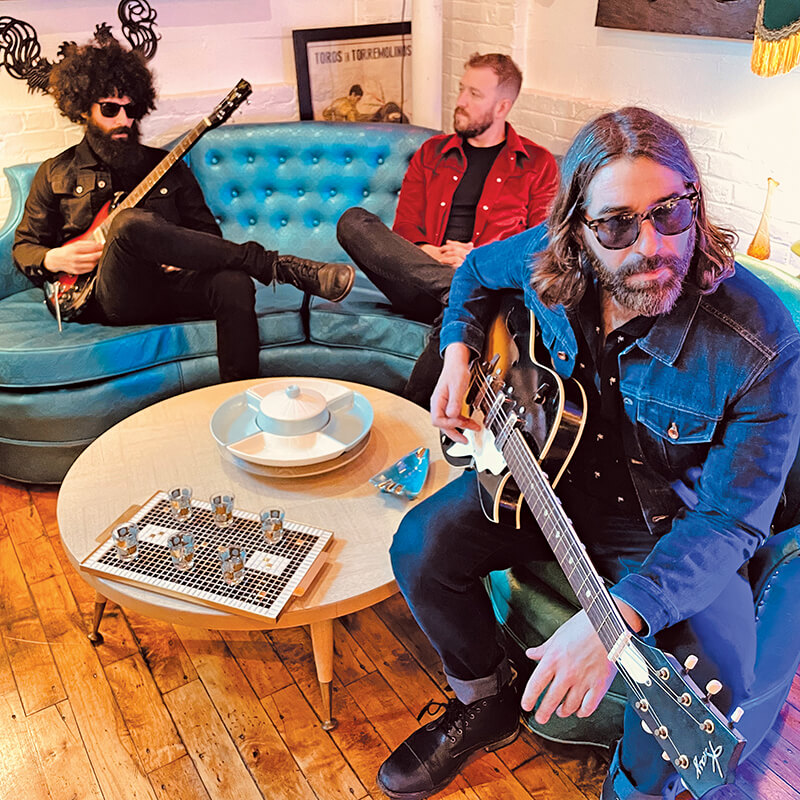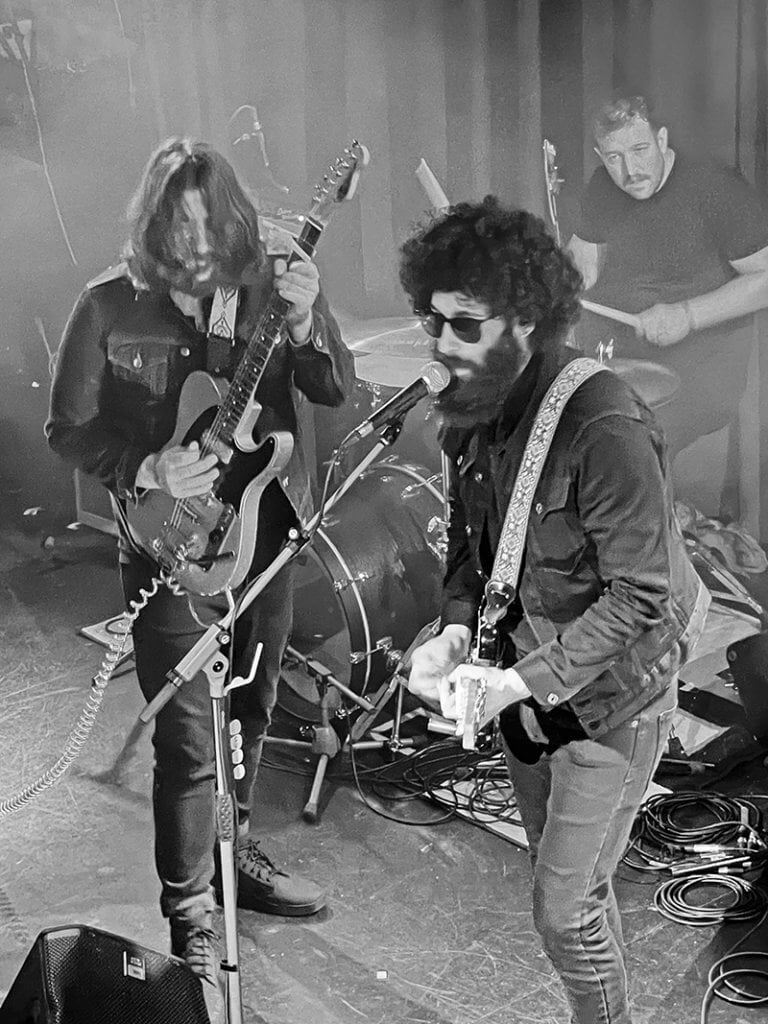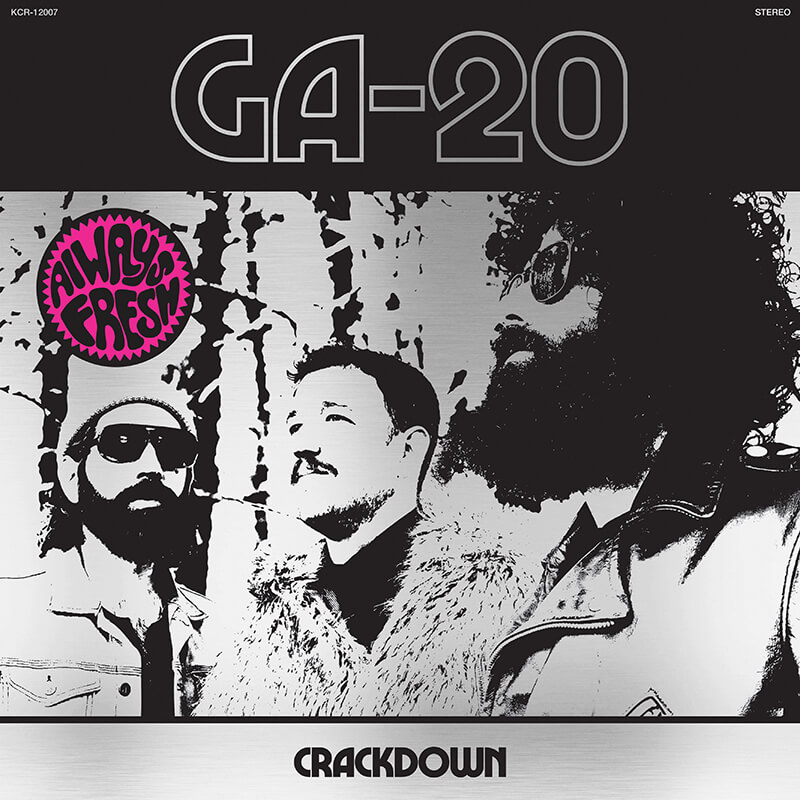If you want to know what GA-20 is all about, just let them tell you about their gear:
“We have guitar and amp collections that allow us to make different choices for particular songs or tunings. For live performances a typical set-up for Matt would be a 1960’s Silvertone 1454 guitar, a 1964 Fender Jazzmaster and/or Telecaster, plugged into a 1965 Fender Vibrolux Reverb and a 1960 GA-20. Pat’s main guitar is a 1950’s Harmony Stratatone Newport, as well as using a modified Fender Jazzmaster, 1960’s Teisco and reissued 1960’s Telecaster. He also uses two amps at the same time, a 1966 Fender Pro Reverb and a modified Fender Pro Junior with a 12 inch speaker. Tim plays a vintage Walberg & Auge kit (sizes 24, 13, 16), and uses Bosphorus cymbals.
In the studio we typically use smaller vintage amps, ranging from 5-12 watts. Some of our go-to’s are a Silvertone 1471, Silvertone 1482, Gibson GA-18, Gibson GA-20. When we need a louder amp we go to the 1960’s Ampeg Reverbrocket 2, a 1951 Fender Tweed Pro, and 1959 Fender Tweed Bassman. We also have a collection of guitars that we don’t usually take out on the road. A few favorites include a 1951 Fender Telecaster, a 1960 Gibson ES-330, a 1968 Fender Jaguar, as well as a bunch of different 50’s and 60’s Kays and Harmonys.”
We recently sat down with Matt Stubbs, GA-20’s lead guitar player (who you might recognize from Charlie Musselwhite’s band) to chat about the GA-20 project, his background with guitar and the group’s vast array of (and love for) vintage gear.
Can you give us a little background on your musical journey?
Sure, so I started playing guitar when I was about 13. My father is a guitarist, so growing up from day one he had a band or different bands, and they’d rehearse every week and have gigs on weekends.
I got interested in trying my hand at it so got a guitar and it took about a year or two to kind of settle in and really get obsessed with it. And once that happened, I had full blinders on. So, I was obsessed with guitar like most kids once they get into it, and I went to Berklee College of Music for a year before I dropped out. And then after that I kind of kicked around New England for a couple years with different bands and got an opportunity to be play guitar for a Blues singer.
Her name is Janiva Magness. She lived in Los Angeles so I moved out to LA my early 20s.
Oh, cool.
I played with her for about a year and then kind of got immersed in the California Blues and R&B scene. I started doing some other gigs aside from Janova…I met a lot of Bay Area musicians at that time and on one of the tours there was a drummer, his name June Core, and he plays drums with Charlie Musselwhite – he’s been in the band forever and I was lucky around that time to have met him.
Charlie needed a guitar player, so he recommended me and one day I got a phone call and it was Charlie on the other end of the line and he offered me a tour. No audition or anything, and I’ve been with [him] ever since. It’s been about 14 or 15 years now.
Let’s take it back a little bit. You went to Berklee? Are you originally from the New England area?
Yeah, I grew up there through high school. I lived in Southern New Hampshire, a little town called Hampstead, and went to Berklee for a year. After that I stayed mostly around Massachusetts, once I dropped out, I went to New Hampshire for a little bit, but yep, I grew up in New England. I live in Providence now, actually.
I’ve never had to get a real job. I’ve always played music. I was working a lot before I went into Berklee, so I was already gigging and doing small tours and I’m pretty sure Berklee changed quite a bit from when I was there. Part of me wishes I stayed for other reasons — I was just studying performance when I was there. And now looking where I am now in life, I produce a lot of music. I produce all the GA-20 stuff. If I could go back in time I might have stayed for another year or two (or maybe four) and work more on engineering and music production, and maybe just kind of learn [that].
So, you did the Charlie Musselwhite thing based upon the recommendation of a fellow musician. You are still with Charlie, right?
I am, yep. But this is the first year where I am missing [a bit]. I’m getting subs for certain gigs, just ’cause GA-20 is pretty much non-stop touring.
GA-20 launched for you maybe a year or two before the pandemic, so maybe you can walk us through what the conception of the project was like.
At the time I was living in downtown Boston near Fenway. And Pat the singer, another guitarist I had known for a few years up until this point — this was end of 2017, beginning of 2018 — he was coming to a lot of my gigs and at the time he was probably a couple years into getting into Blues. He started showing up at different gigs I was doing, and some Blues jams, wanting to learn more about traditional Blues and how to play Blues so he was coming from a jazz background and metal background, but for some reason traditional Blues was speaking to him.

He was out seeking it live and wanting to sit in and stuff. So, he actually took a few guitar lessons with me at first. Not that he needed to learn how to play guitar, but more as like a historical reference for who he should be listening to.
Charlie Musselwhite had just finished making his record with Ben Harper and he let us know that he was going out for a full year on tour, like a world tour with [Ben], and we were gonna be off. His band was going to be off for a full year with no work [for me] and so that was the first time in many years…
You had a hole in your schedule?
Correct — and I had another project, I still do, an instrumental project called Matthew Stubbs and the Antiguas so at that time before GA-20 I was touring with Charlie and when I would be home, I would write music and put out records with that band and just play basically in New England — but being like a psych rock instrumental band, it wasn’t something that was really going to be working four or five nights a week. So, when I got that news, I was talking to Pat. I was thinking about putting a small project together just to work that one year.
I wanted to play straight up ’50s traditional Blues and he was down for it. So that’s how the band started – it was not thinking about making a record. It was really just a band playing the music that I loved.
For the first GA-20 EP, were you doing the recording yourself?
We actually went to Q Division Studios, one of the nicer studios in New England.
OK, that makes sense.
I’m not really an engineer, so I’ll hire an engineer. But I’ll produce everything.

What was your pandemic experience like musically and creatively?
So that Lonely Soul record came out in 2019, and we had a little bit of a head start on the pandemic. Wasn’t like we released our debut record and [everything] shut down [right away] so we put that out and we did a few festivals that year, started working with a different booking agent at the time and started to tour. And we had a big tour lined up for that July 2020 which is when everything got cancelled.
Let’s talk about the home studio. What was that build like?
So, it was a finished basement, when I bought [my] house. The guy that owned it before me had like a small little hair salon out of the basement so when I bought this house, I made it a music room. I mean, I did little demos and stuff; it was not originally a recording area.
During this was when we decided to record Hound Dog, that was like in the middle of COVID, no vaccines yet or anything so going to a studio was not something any of us were really looking to do. But I wanted to do the record, so I had a friend that was great engineer, and he had a lot of gear. So basically, I emptied that room out and built it out. You know, I put a lot of soundproofing and sound dampening in — basic stuff but hung packing blankets and put a window in the wall so there’s like a makeshift vocal booth and just basically built that all out.
Bought some gear, bought some vintage mikes and stuff like that but my engineer Matt Gerard came in with lots of racks of great preamps and great vintage mics. We rented a few other things so basically, I just kind of cleaned the room out and sound treated it and made it my own.
Very few overdubs, very little editing later. We only isolate [vocals]. The biggest reason why [Pat’s] voice gets isolated is for in post-production for syncs like for TV or movies. When you get a sync, sometimes they want the instrumental versions. That’s like 90%. If I didn’t have to do that, I wouldn’t. I would probably put the vocal mic in the room [with the rest of the band].

That makes sense — just cut everything live in the room together?
Yeah, the amps also just sound bigger, man, in a live room. If I put a Super Reverb on 8 and put a 57 in front of it or a Tweed Deluxe [in there] they just, to me, sound bigger in the mix. For drums, I try to use only three or four mics on toms, kick and snare. Sometimes just a single overhead, which is usually a ribbon, and then I usually put a ribbon over [the drummer’s] shoulder behind the floor tom and usually it’s just those two ribbons. I can get 90% of the sound I want, you know, with [just that].
I think on a lot of modern records people are over-mic’ing drums, and I’ve seen setups with bands that we talked to, and they’ve got like 10 to 12 channels on their console filled up with just drums.
Right?
As someone who likes simplicity myself, trying to do a submix on that many mics is going to probably be a nightmare.
When I go to mix I have a mix engineer. I always start with like, “just give me the overhead first,” then let’s either use an overhead or a room mics and then from there, if I need a little bit of snare or a little bit of kick I can control it, there, with [close mics] but I like an open sound. I like bleed. You know, I’m not trying to make pop records here, I’m trying to make blown out 50s and 60s Blues records where they’re wide, wide, open and big, you know? There’s a live intensity to that.

